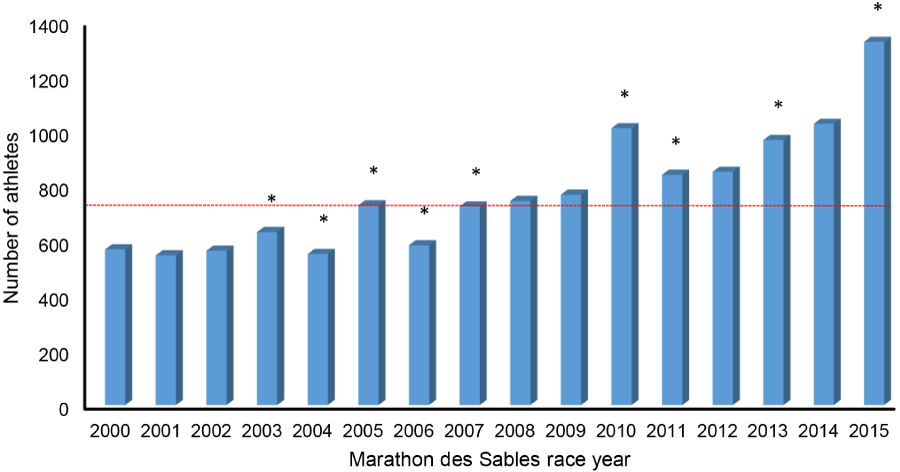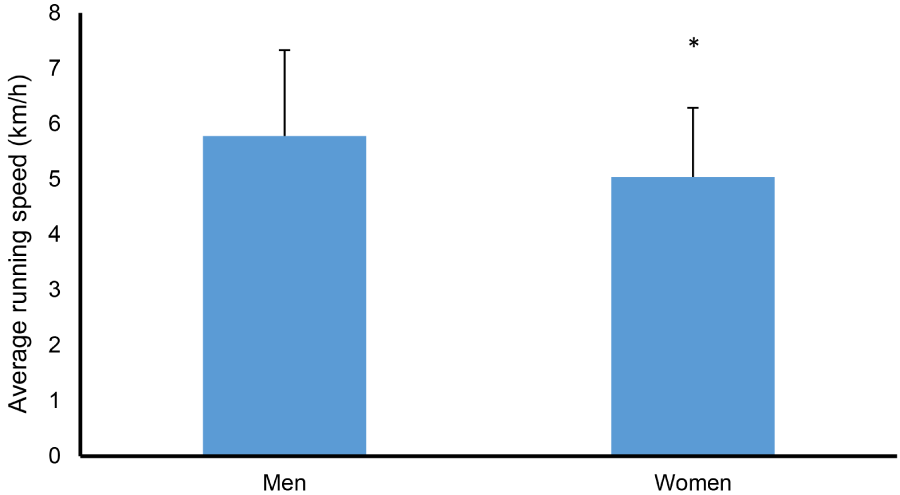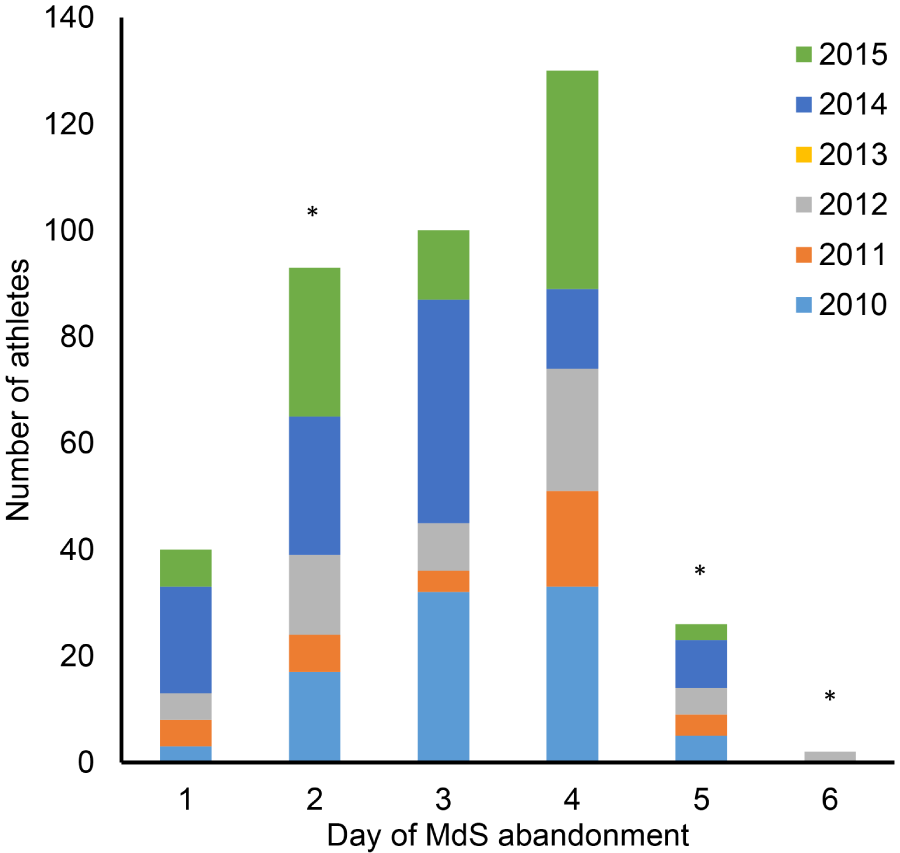The aim of this study was to investigate the impact of aging and sex on athletic performance during the 7-day Marathon des Sables (MdS) in the Sahara Desert. Anonymous data for age, sex, and average running speed (km/h) for all the athletes who registered in the MdS during the period 2000-2015 were retrieved from the official website of the race and other endurance websites. Participants were distributed into the following age groups: 18-22 yrs, 23-27 yrs, 28-32 yrs, 33-37 yrs, 38-42 yrs, 43-47 yrs, 48-52 yrs, 53-57 yrs, 58-62 yrs, 63-67 yrs, and 68-80 yrs. Average running speed (km/h) during the entire race was used to characterize athletic performance. Results showed that the number of participants in the MdS has been steadily increasing from 570 in the year 2000 to 1,329 in the year 2015 (p < 0.001). Men (5.78 ± 1.55 km/h) demonstrate statistically increased performance throughout the MdS compared to women (5.04 ± 1.25 km/h). Abandonment data show that approximately 6.5% of the athletes do not complete the race. The highest performance in the MdS is achieved by athletes 33-42 years-old (p < 0.05). Athletes competing in the MdS are as old as 80 years and the number of athletes older than 52-years-old is increasing. It is concluded that the highest performance in the MdS is achieved by athletes 33-42 years. Nevertheless, ageing past 42 years is associated with decreased performance. Given the steadily increased participation of athletes aged > 52 years, future studies should investigate the physiological impact of this extreme event on elderly individuals during and following the race.
Sahara Desert, Running speed, Extreme sport events, Ultramarathon, Heat stress, Sex, Ageing
The Marathon des Sables (MdS) is considered one of the most challenging ultramarathons in the world [1,2]. In this event, athletes compete for seven days under extreme temperatures reaching 50 ℃ [3]. The running distance per day varies, ranging between 10-92 km and the total distance covered during the race is approximately 220-250 km. In addition, participants must carry their equipment (sleeping bang, clothes, etc.) and food (minimum amount of daily calorie consumption is 2000 kcal, and 4½ L of water per day) throughout the MdS race.
It is well known that aging is associated with a reduced thermoregulatory capacity, especially when exercising in hot environments [4-8] such as the Sahara Desert, the venue of the MdS. Moreover, there are distinct sex differences in thermoregulatory capacity for individuals resting or exercising in the heat [5,7,9,10]. Finally, there is an unanimously accepted negative impact of aging on aerobic fitness [9,11], an essential component of performance in the MdS. Our aim in this study was to investigate the impact of aging and sex on athletic performance during the MdS.
Age, sex, and average running speed (km/h) for all athletes that registered in the MdS during the period 2000-2015 were collected from the official race website [12] as well as from different websites that provide information on the MdS results [13-15].
Participants were divided into 5-year age groups as follows: 18-22 years, 23-27 years, 28-32 years, 33-37 years, 38-42 years, 43-47 years, 48-52 years, 53-57 years, 58-62 years, 63-67 years, and 68-80 years. Average running speed (km/h) during the entire race was used to describe athletic performance.
Chi-square tests were used to compare the number of registered athletes at different years, as well as the numbers that abandoned the MdS at different days of the race. One-way analysis of variance with post hoc t tests incorporating a Bonferroni adjustment was used to assess group differences in performance. Pearson's correlation was used to evaluate the associations between average running speed and either age or sex. All statistical analyses were conducted using the SPSS 22 (IBM, Armonk, NY, USA) statistical software. The level of statistical significance was set at p < 0.05.
The number of participants in the MdS has been steadily increasing from 570 in the year 2000 to 1,329 in the year 2015 (p < 0.05; Figure 1). Overall, a total of 10,628 men and 1,639 women participated in the race in the period 2000-2015 (p < 0.05). The men (5.78 ± 1.55 km/h) demonstrated statistically increased performance throughout the MdS compared to women (5.04 ± 1.25 km/h; p < 0.001; Figure 2). Abandonment data were available for the events organized between 2010 and 2015 (Figure 3). A total of 391 athletes (6.48%) of the total 6,038 athletes that competed between 2010 and 2015 abandoned the race. The abandonment prevalence was 8.9% in 2010, 4.5% in 2011, 6.9% in 2012, 0% in 2013, 10.9% in 2014, and 6.9% in 2015 (p < 0.05).
 Figure 1: Number of participants in the MdS during the years 2000-2015. All values above the red line had a statistically significant increase in participation of athletes compared to the year 2000 (p < 0.05).
Figure 1: Number of participants in the MdS during the years 2000-2015. All values above the red line had a statistically significant increase in participation of athletes compared to the year 2000 (p < 0.05).
Note: Difference compared to the previous (to the left) year statistically significant at *p < 0.05. View Figure 1
 Figure 2: Average running speed (mean ± sd) in men and women throughout the MdS during the years 2000-2015.
Figure 2: Average running speed (mean ± sd) in men and women throughout the MdS during the years 2000-2015.
Note: *Difference between sexes statistically significant at p < 0.001. View Figure 2
 Figure 3: Number of athletes who abandoned the MdS at various days throughout the 7-day event in the years 2010-2015 (the period where for which such data is available).
Figure 3: Number of athletes who abandoned the MdS at various days throughout the 7-day event in the years 2010-2015 (the period where for which such data is available).
Note: Difference from previous day of MdS abandonment significant at *p < 0.05. View Figure 3
Athletes' age ranged from 18 years to 80 years (41.8 ± 9.7; Table 1). The athletes in the age groups 33-37 and 38-42 years-old revealed the highest performance values. Specifically, their average running speed was significantly higher compared to all the other age groups (p < 0.05; Table 1 and Figure 4). After the age of 42, there was statistically significant reduction in performance in nearly each additional 5-year category (p < 0.05; Table 1 and Figure 4). For the same age range (i.e., > 42 years), Pearson's product moment correlation coefficient demonstrated an inverse relationship between age and MdS performance (r = -0.224, p < 0.001).
 Figure 4: Average running speed (mean ± sd) in each age group throughout the MdS.
Figure 4: Average running speed (mean ± sd) in each age group throughout the MdS.
Note: Difference compared to the previous (to the left) age group statistically significant at *p < 0.05 and **p < 0.001. View Figure 4
Table 1: Number and percentage of athletes as well as average running speed (mean ± sd) for the different age groups. View Table 1
Interestingly, the number of athletes aged ≥ 53 years in the MdS during the years 2000-2015 is steadily increasing from 43 athletes during 2000 to 218 athletes during 2015 (p < 0.05; Figure 5). Moreover, the participation of athletes aged ≥ 53 years is significantly greater in the vast majority of MdS events organized after 2004, as compared to our baseline year of 2000 (p < 0.05) (Figure 6). Finally, it is worthwhile to mention that, despite this 4-fold increase in the participation of athletes aged ≥ 53 years in the MdS during the years 2000-2015, the average running speed of this age group remains stable, indicating that the athletic capabilities of the competitors remain equally high (p > 0.05).
 Figure 5: Number of athletes aged ≥ 53 years in the MdS during the years 2000-2015. All values above the red line had a statistically significant increase in participation of athletes aged ≥ 53 years compared to the year 2000 (p < 0.05).
Figure 5: Number of athletes aged ≥ 53 years in the MdS during the years 2000-2015. All values above the red line had a statistically significant increase in participation of athletes aged ≥ 53 years compared to the year 2000 (p < 0.05).
Note: Difference compared to the previous (to the left) year statistically significant at *p < 0.05. View Figure 5
 Figure 6: Average running speed (mean ± sd) for the athletes aged ≥ 53 years throughout the MdS during the years 2000-2015.
Figure 6: Average running speed (mean ± sd) for the athletes aged ≥ 53 years throughout the MdS during the years 2000-2015.
Note: Difference compared to the previous (to the left) year statistically significant at *p < 0.05. View Figure 6
The main finding of the present study was the relationship between age and average running speed. Specifically, our results revealed that athletes in the age groups 33-37 and 38-42 years-old revealed the highest performance values, their average running speed being significantly higher compared to all the other age groups. Moreover, after the age of 42, we detected a statistically significant reduction in performance with nearly each additional five years of aging. This result was confirmed by the finding that, in the athletes aged > 42 years, we found an inverse relationship between age and MdS performance. These findings are consistent with previous studies showing that older participants need more time to finish marathons compared with younger participants [16,17]. Nevertheless, we found surprising that the highest average running speed was not displayed by the youngest athletes (18-22 years-old). Instead, participants with age range between 33-42 performed better than their young counterparts. It is well-known that a decline in aerobic fitness and overall physical performance starts at around the age of 40 years [9,11,15,18]. Furthermore, heat loss through the evaporation is also increased in older individuals [6], which may further impair athletic performance. Therefore, the fact that athletes 33-42 years demonstrated improved performance compared to younger participants could be due to the fact that older athletes might be more experienced on this type of ultramarathon races.
Performance during extreme sport events seem to be different between the sexes. The present study revealed that men have a higher average running speed compared to women. This finding could be due to the fact that, in general, women have lower aerobic capacity compared to men [19]. Also, another factor that can affect the average running speed of women is that females have smaller body surface compared to males and more adipose tissue (which may less heat loss than men) [20].
The number of individuals participating in extreme sport events as the MdS have been increasing since 2000 as showed in this study. As this event takes place on the Sahara Desert under extreme weather temperature, future studies should be considered monitoring participants on their physiological response to exercise on this extreme weather environment. Special attention should be given to older individuals since it has been reported their reduced capacity to adapt to temperature changes [21]. Indeed, environmental physiology studies clearly show that extreme temperatures can significantly increase mortality in elderly individuals [21]. In accordance, future studies should focus on the effects of temperature on older athletes' performance not only during the race, but also after the race.
The number of participants in the MdS has been steadily increasing in the past 15 years. Men demonstrate increased performance throughout the MdS compared to women, while abandonment data show that approximately 6.5% of the athletes do not complete the race. Nevertheless, athletes competing in the MdS are as old as 80 years and the number of athletes older than 52-years-old is steadily increasing. In this regard, it is telling that the highest performance in the MdS is achieved by athletes 33-42 years-old, while aging is associated with reduced performance in competitors aged 43-80 years.